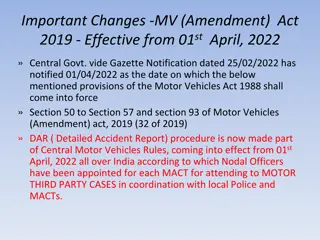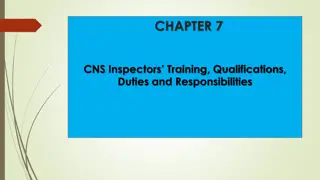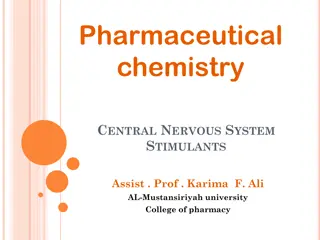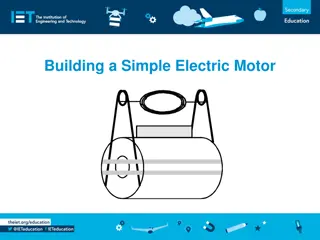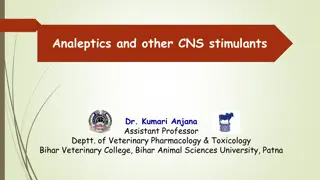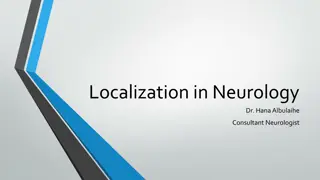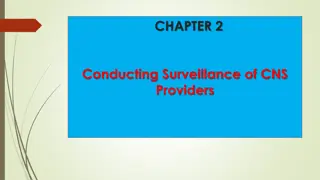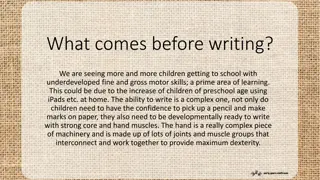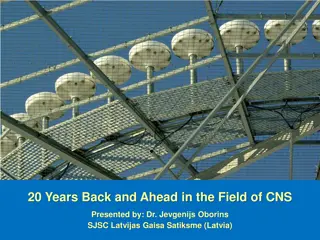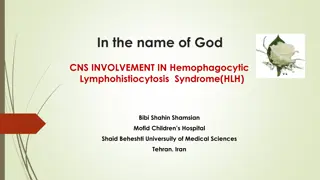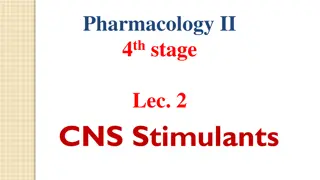Motor functions of the CNS
Explore the different classes of movements and descending pathways involved in motor control in the central nervous system. Images and explanations provided by Dr. Safaa Al-Shammary.
- motor functions
- CNS
- reflexes
- higher motor control
- voluntary movement
- rhythmic motor patterns
- descending pathways
- reticulospinal tracts
- vestibulospinal tract
- rubrospinal tract
- tectospinal tract
- corticospinal tract
Download Presentation

Please find below an Image/Link to download the presentation.
The content on the website is provided AS IS for your information and personal use only. It may not be sold, licensed, or shared on other websites without obtaining consent from the author. Download presentation by click this link. If you encounter any issues during the download, it is possible that the publisher has removed the file from their server.
E N D
Presentation Transcript
Motor functions of the CNS Dr. Safaa Al-Shammary
Motor functions of the CNS 1-Reflexes. 2-Higher motor control.
There are three classes of movements: [a] Voluntary movement: Complex actions such as in daily activities, sitting standing, writing, playing piano. They are purposeful, goal-oriented and learned type of activity . [b] Reflexes : Involuntary, rapid, stereotyped movement such as in response to painful stimuli when you drag your arm away from this stimuli, eye-blink, coughing, knee jerk.
[C] Rhythmic motor patterns (mixed pattern): Combine voluntary & reflexive acts such as chewing, walking, running. It is initiated and terminated voluntarily, but once initiated it become repetitive and reflexive.
Descending pathways involved in motor control: 1-The reticulospinal tracts. 2-The vestibulospinal tract . 3-The rubrospinal tract. 4-The tectospinal tract . 5-The corticospinal tract.
Descending pathways involved in motor control The reticulospinal tracts influence mainly the muscles of the trunk and proximal parts of the limbs. The medial (pontine) reticulospinal tract enhances the extensor tone, whereas the lateral (medullary) reticulospinal tract inhibits extensors. The vestibulospinal tract terminate on interneurons in the ipsilateral spinal cord. These interneurons control the activity of extensor muscles and are important in the maintenance of an erect posture, making adjustments in response to signals from the vestibular apparatus.
The lateral vestibulospinal tracts, which can excite extensor and inhibit flexor motor neurons especially related to movements of the head. The medial vestibulospinal tracts makes connections with cervical and upper thoracic spinal motor neurons which are involved in reflex adjustments of the head in the space .
The rubrospinal tract terminate in the contralateral gray matter of the spinal cord, and synapse with interneurons controlling both flexor and extensor muscles. The rubrospinal tract is involved in large movements of proximal musculature of the limbs. It inhibits activity of extensors, and increases activity of flexors.
The tectospinal tract projects to contralateral cervical regions of the cord and makes synaptic contact with interneurons controlling head and eye movements. Mediates contralateral movements of the head in response to auditory, visual and somatic stimuli. The corticospinal tract: The lateral corticospinal tracts (direct tract) of the cord are concerned with distal limb muscles ( hands and fingers). The ventral (anterior) corticospinal (corticoreticulospinal tracts, indirect tract) are concerned with axial and proximal limb (girdle) muscle contraction
Spinal cord cross section: The alpha motor neurons The gamma motor neurons
The basic unit of integrated neural activity reflexes is the reflex arc which considered the link between the sensory and the motor system. The arc consists of a sense organ (receptor), an afferent neuron, one or more synapses in a central integrating station or sympathetic ganglion, an efferent neuron, and an effector. The connection between the afferent and efferent neurons is generally in the brain or spinal cord.
The afferent neurons enter via the dorsal roots or cranial nerves and have their cell bodies in the DRG or in the homologous ganglia on the cranial nerves. The efferent fibers leave via the ventral roots or corresponding motor cranial nerve. The connection between the afferent and the efferent neurons is usually in the CNS and activity in the reflex arc is modified by multiple input converging on them from higher motor control centers.
(1) Stimulus (2) Receptor sensory neuron (3) CNS (spinal cord) motor neuron (4) Effector (5) Response
Characters of Reflex Action 1. Important role in protection of the body. 2. Responsible for maintenance of: a. Muscle tone. b. Body posture. 3. Center can be anywhere except cerebral cortex. 4. Center can be in spinal cord or in brain stem.
The reflex arc consists of: 1. 2. 3. 4. 5. Receptor Afferent nerve fiber (sensory neuron) Reflex center (integration center) Efferent nerve fiber (motor neuron) Effector (skeletal muscles, smooth muscles, cardiac muscles, glands)
The spinal cord reflexes: After entering the cord, every sensory signal travels to two separate destinations: 1- The sensory nerve terminate in the gray matter of the cord and elicit local segmental motor responses. 2- The signals travel to higher levels of the cord itself or to the brain stem or even to the cerebral cortex.
Each segment of the spinal cord has several millions neurons in its gray matter and these are: A- The sensory neurons. B- interneuron. B- The anterior motor neurons: Nerve fibers leave the cord via the anterior roots and innervate the effector such as skeletal muscle fibers.
The cells of the anterior horn of SC or motor cranial nuclei and their efferent fibers that run to motor units are also called the lower motor neurons. The LMN is the final common path for all efferent impulses directed at the muscle.
The anterior motor neurons are of two types: 1. Alpha motor neurons: Transmit impulse through A fibers (14 m) innervate large skeletal muscle fibers. Stimulation excites muscle fibers called the "motor units". 2. Gamma motor neurons or gamma efferent neurons: Transmit impulse through A fibers (5 m) innervate intrafusal fibers which are part of the muscle spindle help to control basic muscle tone. 3-100s skeletal
3- The interneurons: These are small neurons that have many interconnections one with the other.
Some of the anterior motor neurons immediately after the motor axons leave the soma give collateral branches to innervate an adjacent interneurons called Renshaw cells. These cells in turn are inhibitory cells that transmit inhibitory signals to the same motor neuron (recurrent inhibition) and to the nearby motor neurons (lateral inhibition).
Renshaw cell: is small inhibitory interneuron in the anterior horn ( Glycine is its inhibitory transmitter) These inhibitory neurons which make a connection between the: 1. Collateral branch of LMN & 2. Axon of LMN itself It produce a negative feedback effect preventing over excitation of motor neurons. Inhibition of the surrounding neurons help to focus the motor activity.
The recurrent inhibition is important to allow only the initial impulses to pass while the late impulses will find the AHC partially inhibited and produce a smaller motor discharge than the initial excitatory impulses "negative feedback" circuit, and protects the body from over activity of the motor neuron concerned, and therefore damage to the muscle. The lateral inhibition is to focus or sharpen the signals that is to allow transmission of the primary signal while suppressing the tendency for signals to spread to adjacent neurons.
Muscle Receptors Major role in proprioception Stretch receptors detect changes in length and tension of muscle fibers. 2 types of receptors Muscle spindles & Golgi tendon organs differences in threshold & location ~
Muscle Sensory Receptors Proper control of muscle function requires: Excitation by anterior motor neurons Continuous sensory feedback information from each muscle muscle status - that is: A. What is the length of the muscle? B. What is its tension? C. How rapidly length or tension changing? Muscle spindles & Golgi tendon organs.
Intrafusal Skeletal Muscle Fibers Small skeletal muscle fiber I. Central region - no or few actin and myosin filaments does not contract when ends do (Function as sensory receptors). II. End portions that do contract - excited by small gamma motor neurons.
The muscle receptors : Two special types of sensory receptors and these are: 1 Muscle spindles: distributed throughout the belly of muscle and which send information to the NS about the muscle length and the rate of change of its length. 2 Golgi tendon organs: located among the fascicles of a tendon between it and the muscle itself and which send information about tension or rate of change of tension.
Muscle spindle: Consists of 3 10 specialized muscle fibers enclosed in a connective tissue capsule. These fibers are called intrafusal muscle fibers to distinguish them from the (extrafusal muscle fibers).
Each fiber whether nuclear bag or nuclear chain has: 1- Central non contractile part= sensory receptor. area. 2- peripheral contractile part= effector area.
Two types of intrafusal fibers : Nuclear chain fibers (which detect the changes in muscle length, i.e. static changes) . Nuclear bag fiber (which detect the rate of change in muscle length, i.e. dynamic changes).
The receptor portion of the muscle spindle is stimulated by stretch of the mid portion of the spindle. 1 Lengthening the whole skeletal muscle which will stretch the mid portions of the spindle and therefore excite the receptor. 2 Stimulation of the peripheral parts of the intrafusal fibers i.e. supraspinal gamma efferent Contraction of the end-portions of the intrafusal fibers by increase stimulation of gamma motor neurons will stretch the mid portions of the spindle and therefore excite the receptor and increases the rate of firing while shortening the mid portion of the muscle spindle by inhibition of gamma motor fibers decreases this rate of firing.
The number of impulses transmitted from the muscle spindles increases directly in proportion to the degree of stretch and the rate of change of its length and continues for as long as the receptor itself remains stretched.





